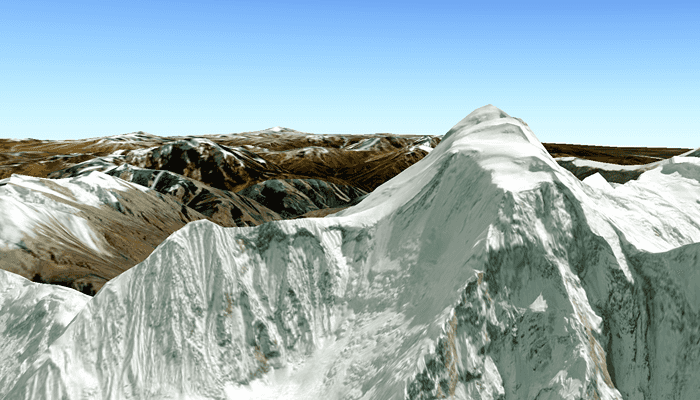Display a scene with a terrain surface and some imagery.

Use case
Scene views are 3D representations of real-world areas and objects. Scene views are helpful for visualizing complex datasets where 3D relationships, topography, and elevation of elements are important factors.
How to use the sample
When loaded, the sample will display a scene. Pan and zoom to explore the scene.
How it works
- Create an
ArcGISSceneobject with theBasemapStyle.ArcGISImagerybasemap. - Create an
ArcGISTiledElevationSourceobject and add it to the scene's base surface. - Create a
SceneViewobject to display the scene. - Set a
Camerato the view usingSceneView.setViewpointCamera() - Set the scene to the scene view.
Relevant API
- ArcGISScene
- ArcGISTiledElevationSource
- BasemapStyle
- Camera
- SceneView
Tags
3d, basemap, elevation, scene, surface
Sample Code
MainActivity.kt
/* Copyright 2023 Esri
*
* Licensed under the Apache License, Version 2.0 (the "License");
* you may not use this file except in compliance with the License.
* You may obtain a copy of the License at
*
* http://www.apache.org/licenses/LICENSE-2.0
*
* Unless required by applicable law or agreed to in writing, software
* distributed under the License is distributed on an "AS IS" BASIS,
* WITHOUT WARRANTIES OR CONDITIONS OF ANY KIND, either express or implied.
* See the License for the specific language governing permissions and
* limitations under the License.
*
*/
package com.esri.arcgismaps.sample.displayscene
import android.os.Bundle
import androidx.appcompat.app.AppCompatActivity
import androidx.databinding.DataBindingUtil
import com.arcgismaps.ApiKey
import com.arcgismaps.ArcGISEnvironment
import com.arcgismaps.mapping.ArcGISScene
import com.arcgismaps.mapping.ArcGISTiledElevationSource
import com.arcgismaps.mapping.BasemapStyle
import com.arcgismaps.mapping.view.Camera
import com.esri.arcgismaps.sample.displayscene.databinding.DisplaySceneActivityMainBinding
class MainActivity : AppCompatActivity() {
// set up data binding for the activity
private val activityMainBinding: DisplaySceneActivityMainBinding by lazy {
DataBindingUtil.setContentView(this, R.layout.display_scene_activity_main)
}
private val sceneView by lazy {
activityMainBinding.sceneView
}
override fun onCreate(savedInstanceState: Bundle?) {
super.onCreate(savedInstanceState)
// authentication with an API key or named user is
// required to access basemaps and other location services
ArcGISEnvironment.apiKey = ApiKey.create(BuildConfig.ACCESS_TOKEN)
lifecycle.addObserver(sceneView)
// create an elevation source, and add this to the base surface of the scene
val elevationSource = ArcGISTiledElevationSource(
resources.getString(R.string.elevation_image_service)
)
// create a scene with a imagery basemap style
val imageryScene = ArcGISScene(BasemapStyle.ArcGISImagery).apply {
// add the elevation source to the base surface
baseSurface.elevationSources.add(elevationSource)
}
// add a camera and initial camera position
val camera = Camera(
latitude = 28.4,
longitude = 83.9,
altitude = 10010.0,
heading = 10.0,
pitch = 80.0,
roll = 0.0
)
// apply the scene to the sceneView and set its viewpoint
sceneView.apply {
scene = imageryScene
setViewpointCamera(camera)
}
}
}